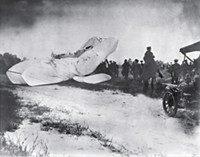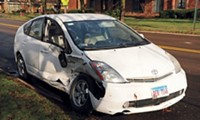Advertisement
Grab your lab coat. Let's get started
Welcome!
Welcome!
Create an account below to get 6 C&EN articles per month, receive newsletters and more - all free.
It seems this is your first time logging in online. Please enter the following information to continue.
As an ACS member you automatically get access to this site. All we need is few more details to create your reading experience.
Not you? Sign in with a different account.
Not you? Sign in with a different account.
ERROR 1
ERROR 1
ERROR 2
ERROR 2
ERROR 2
ERROR 2
ERROR 2
Password and Confirm password must match.
If you have an ACS member number, please enter it here so we can link this account to your membership. (optional)
ERROR 2
ACS values your privacy. By submitting your information, you are gaining access to C&EN and subscribing to our weekly newsletter. We use the information you provide to make your reading experience better, and we will never sell your data to third party members.
Materials
Materials For The Modern Gladiator
Thanks to innovations in materials science and engineering, NASCAR drivers can crash at 200 mph and walk away from the wreckage
by Bethany Halford
February 2, 2009
| A version of this story appeared in
Volume 87, Issue 5

MICHAEL MCDOWELL owes his life to materials science. On April 4, 2008, the 23-year-old rookie driver was speeding though a qualifying run for the Samsung 500 at the Texas Motor Speedway, one of the major events for the National Association for Stock Car Auto Racing—better known as NASCAR—when he lost control of his car.
As McDowell turned into his second lap, the vehicle hooked and slammed into the track's outer wall at around 180 mph. The impact spun the car upside down and then sent it barrel-rolling eight times down the track, bursting into flames and shedding bumpers, wheels, and stray scraps of metal into the air before finally coming to a rest.
"Oh my gosh, I have never seen anything like that in my life," said NASCAR commentator and veteran driver Darrell Waltrip as he watched the quarter-million-dollar machine crumple into a mass of metal. The speedway crowd collectively held its breath until moments later, when McDowell emerged from the vehicle, waving to fans as he walked to a waiting ambulance.
"I feel very grateful and blessed that I'm sitting here right now," McDowell said at a press conference two days later, "because five years ago, four years ago, maybe even just a year ago, I don't think that would be, probably, possible."
That McDowell was able to walk away from that horrendous wreck with just a few bruises "was a culmination of all of the systems designed around safety that NASCAR has put in place over the last six or seven years," says Mike Fisher, managing director of the NASCAR R&D Center, in Concord, N.C.
Those new systems, which range from the league's new car to the drivers' clothes to the barrier that surrounds the track, save lives because of advances in materials science. As NASCAR's 2009 racing season kicks off this week at Florida's Daytona International Speedway, NASCAR's drivers—effectively gladiators for the 21st century—will once again be counting on advanced materials to cheat death.
"NASCAR's biggest contribution to you and me is safety."
Diandra Leslie-Pelecky, a physics professor at the University of Texas, Dallas, and author of the book "The Physics of NASCAR" and the blog "Stock Car Science," says materials science is something that NASCAR has rediscovered in the past few years. Until the 1980s, innovations in NASCAR were mainly made by mechanics and engineers tinkering in the garage.
"Then racing teams started realizing that they could really get ahead by capturing the expertise of people who had been to school and had been formally trained," she explains. Chemical engineers who could maximize efficiency from combustion processes were sought out, as well as mechanical engineers and aerodynamics experts. Cars got a lot faster.
BUT INNOVATIONS in safety didn't keep pace with innovations in speed. Between May 2000 and February 2001, crashes claimed the lives of four NASCAR drivers. Nineteen-year-old Adam Petty and 30-year-old Kenny Irwin Jr. had eerily similar fatal accidents just eight weeks apart at the New Hampshire International Speedway. Tony Roper, 35, died during a race at the Texas Motor Speedway. The sport's highest profile fatality was that of its star Dale Earnhardt Sr., after a collision in the last lap of the Daytona 500 in 2001.
NASCAR's 75 million fans expect to see spectacular crashes, but they also expect the drivers they loyally cheer for, week after week, to walk away from the wreckage. "NASCAR has been doing things since its inception to improve the safety of racing," Fisher says, "but we recognized with that string of fatalities that we needed to step our game up."
The NASCAR R&D Center was established, in part, to guide these safety innovations, including the redesign of the stockcar. When researchers at the center started looking around to see how to make the new car so that drivers could continue to race at breakneck speeds but still be safe, Leslie-Pelecky says, "that's when they realized materials science was important." NASCAR introduced the Car of Tomorrow—now known as the CoT or "the new car"—in 2007, when it ran in a few races. Since 2008, it's the only racecar to run in NASCAR's major series.
The R&D center engineers designed the new vehicle with a splitter—a shelf, about half an inch thick, under the car's nose. "It's called a splitter because it splits the air hitting the front of the car," Leslie-Pelecky explains. "Some of the air goes up on top, some goes on the bottom, and that differential is what pushes the car down into the ground and gives it grip."
While choosing a material for the splitter, NASCAR looked at everything from plywood to expensive advanced carbon-fiber composites. In 2005, Steve Peterson, who was technical director of the R&D center until his death last year, was reading trade magazines when he saw a short article announcing a material from Milliken called Tegris. Milliken is only a 90-minute drive from the R&D center, so Peterson called the company and asked to see the material.

Tegris is a polypropylene composite that weighs roughly the same as carbon fiber. It comes close to carbon fiber's strength at a fraction of its cost. "Anytime NASCAR finds a material that can do the same job for less money, they're going to use it because that's more money that can be put into making the car go fast," Leslie-Pelecky explains. Peterson saw it and decided it was the right stuff for the splitter.
Heather Hayes, a senior development chemist at Milliken, says the secret to Tegris' strength is in its structure. "It starts with a polypropylene tape that has a surface layer that melts at a lower temperature than the bulk," she says. "The core of tape is highly oriented, which gives it stiffness, and the surface layers of the tape act as the matrix or the glue that holds the whole thing together."
To make Tegris, the tape is woven into a fabric, which is then stacked into layers and subjected to heat and pressure. The resulting material is still composed of layers of fabric, Hayes explains, but they're all bonded together so well that the final product is very rigid.
Tegris has a very high impact resistance. On the rare occasions that it does fail, it breaks cleanly; it doesn't fail in a brittle fashion, which was important to NASCAR. "You don't have anything that ends up as debris on the track or that may fly into a driver's path or into the stands," Hayes says.
"The reason for that is Tegris is made of a bunch of different layers of fabric. Even after it's been consolidated under heat and pressure, it still maintains the individual fabric characteristics," she explains. "So, you can't drive a crack through the thickness of the layers. You have to tear each individual layer in order to break through it. In standard plastic materials, if you get a crack started, it can propagate all the way through the thickness and shatter."
NASCAR uses Tegris for the splitter and to reinforce other parts of the stockcar. Its impact resistance makes it attractive for military applications, such as vehicle armor. It's also being used to make kayaks. When a Tegris boat was introduced at a sporting goods expo, visitors were invited to test its impact resistance by whacking it with a sledgehammer.
One of the most substantial materials-related changes to the new car is the addition of energy-absorbing Impaxx foam in the car doors. "The old car was pretty good in front and rear impact crashes, but one of the worst kind of crashes is when you get T-boned—when a car comes in perpendicular to the drivers' side door," Leslie-Pelecky says. There's just less stuff between the driver and whatever is hurtling toward him in side-impact crashes.
Leslie-Pelecky says the R&D center evaluated more than 200 materials before settling on Impaxx, made by Dow Automotive. The material itself is polystyrene—the same polymer in disposable coffee cups—that's blown into a foam with carbon dioxide. The gas introduces air pockets into the polymer. Some foams have a so-called open-cell structure, in which these air pockets interconnect, making the material flexible and squishy because air is easily compressed through the foam.
Impaxx, on the other hand, has a closed-cell structure. Each air bubble is isolated, so compressing the material beyond a certain point requires breaking the polystyrene walls between cells. "We've designed the foam so that when it is impacted it compresses and buckles, thereby absorbing the maximum amount of energy possible," says Marie Winkler-Sink, global R&D director for Dow Automotive.

The material, which was first commercialized in 2006, was invented as an impact-resistant foam for passenger vehicles. Impaxx foam is used in more than 2 million automobiles, including the Chevy Malibu, Ford Crown Victoria, and Honda Pilot.
"Stockcars need significantly more energy absorption than a typical passenger car would need," Winkler-Sink notes, but the material proved to be strong enough for the CoT, as McDowell's crash so dramatically demonstrated.
Leslie-Pelecky has examined what remains of McDowell's crashed car. "You can see the Impaxx foam in the door," she says. "It crushed exactly the way it was supposed to. The front of the car is smushed. The back of the car is almost gone. That area around the driver, which is the part that has the strongest construction and all the foam, that's still almost entirely intact."
"I feel that the car is safer from a structural standpoint with the added foam and the things they have done to protect drivers during side impacts and angular impacts," NASCAR driver Ryan Newman tells C&EN. In addition to having had a long career in racing, Newman also holds a bachelor's degree in vehicle structure engineering from Purdue University.
The CoT's safety has come at a cost, however. "The car is definitely slower, and from a driver's standpoint, that's a disappointment," Newman says. "The next evolution of whatever you build should be higher performing, whether it's a computer or a racecar. But NASCAR is still working to give us the best of both worlds—safety and a better performing racecar on the track."
FROM A DRIVER'S perspective, though, the biggest safety concern is fire, Newman says. "Fire is relatively uncontrollable in a worst-case scenario," he says.
NASCAR drivers, along with their pit crews and racetrack emergency workers, all wear flame-resistant clothing. Firesuits made from DuPont's Nomex have been popular at racetracks for decades. Firefighters, utility workers, petrochemical industry workers, and military personnel also wear garments made from the material.
Nomex has been around for more than 40 years. It's an isomeric sibling of a more famous DuPont fiber, Kevlar. Both Nomex and Kevlar are aramids or polymeric aromatic amides. Kevlar is a para-aramid and Nomex is a meta-aramid. Simply moving the amide from the para to the meta position of the material's aromatic rings transforms it from a very strong polymer to one that has excellent fire-resistance and is comfortable enough for use in clothing.
"It has a very high glass transition temperature," the temperature at which it gets soft, "so its resistance to high temperature is very good," says Vlodek Gabara, a DuPont scientist who works on advanced fibers. Nomex' fire-resistance is based on the nature of the fiber itself rather than a coating, so you can't wash away its flame-protection properties in the laundry.
Over the years, Nomex firesuits have been improved by blending the material with Kevlar fibers, adds Norfleet N. Smith Jr., a manager for DuPont Personal Protection. "Kevlar is a very mechanically stable fiber, so when it's exposed to high temperatures it doesn't shrink or move, but it's not very textilelike," Smith explains. "It's not the softest fiber, whereas Nomex is very textilelike. Pure Nomex would tend to break away from the flame, so we put Kevlar into it to keep the fabric from breaking open."
In the past decade, another flame-resistant material, CarbonX from Chapman Innovations, has become popular. CarbonX was originally conceived for the motor sports world by Mike Chapman, the company's founder and a racing-engine specialist. After seeing a number of his racing buddies seriously injured by fire, Chapman started experimenting with fire-resistant textiles.
Advertisement
CarbonX is made from fibers of oxidized polyacrylonitrile (OPAN). As the name suggests, it's made by heating an acrylic precursor until it becomes fully oxidized and no longer has any melting characteristics at all. Essentially, it's preburnt, explains Bob Goulet, chief operating officer at Chapman Innovations. "You can take a blowtorch to it and the material doesn't shrink, it doesn't disappear, it doesn't support combustion," he says.
The preburnt fibers are black, which is something of a problem in a sport like NASCAR, where flashy firesuits emblazoned with sponsor logos are the standard uniform. But CarbonX undergarments, gloves, and shoe liners are popular. The material is also used as heat shields and to cover flammable foam components in stockcars as well as in helmets.
Like Nomex, CarbonX's biggest market is in the industrial sector. Goulet says he's frequently regaled with tales of how CarbonX kept molten metal from burning steel mill workers when he goes on site visits. He's even tried the stuff himself, suiting up in CarbonX and walking through fire for 22 seconds.

OPAN is somewhat fragile, Goulet notes, so it's typically woven with some other fiber, depending upon the application. The company has also looked into making flame-resistant covers for homes threatened by forest fires. Combining CarbonX with stainless steel fibers reinforces the material and lets it resist heat for longer periods of time without losing tensile strength.
If NASCAR drivers are lucky, they'll never even come into contact with one of the biggest safety innovations the league has introduced—the Steel & Foam Energy Reduction (SAFER) barriers that have been placed in front of the concrete walls that surround the tracks.
CONCRETE DOESN'T absorb energy very well, so when stockcars plow into it, all the energy bounces right back into the vehicle, propelling it back onto the track. The SAFER barrier, which is made of structural steel tubes welded together and backed by stacks of foam, moves when a car hits it, dissipating the energy somewhat and drawing out the duration of the collision.
Dean Sicking, an engineering professor at the University of Nebraska, Lincoln, and director of the Midwest Roadside Safety Facility, led the team that developed the barrier. The Indy Racing League initiated the project, but NASCAR became involved later on, in part because both leagues use the Indianapolis Motor Speedway. Stockcars weigh about twice as much as Indy cars, so Sicking's team needed to design a barrier that could be used with both types of vehicle.
Sicking says he chose steel because he needed a smooth, low-friction surface, as well as something that was tough and durable. Finding a foam material was more difficult. "Most high-efficiency foams turn to dust when impacted," he says. That's a problem in racing because the dust gets on the track and causes more wrecks.
After testing more than 100 foams, they settled on Owens Corning Formular 150, which is a common building insulation material. "It's kind of ironic that the cheapest foam we could find was the one that worked the best," Sicking says. The material is a closed-cell polystyrene similar to Impaxx, which wasn't around when the SAFER barrier was developed.
Sicking is currently hoping to find some funding to develop similar barriers for high-risk areas of highways. "We are very confident that we can make this barrier improve safety along all highways that have concrete barriers," he says. "We think we can dramatically reduce fatality rates."
Such innovations, which have been spurred or popularized by NASCAR, could ultimately transform the reputation of a sport that's known for danger. When it comes to our cars and the roads we drive on, University of Texas' Leslie-Pelecky points out, "NASCAR's biggest contribution to you and me is safety."





Join the conversation
Contact the reporter
Submit a Letter to the Editor for publication
Engage with us on Twitter